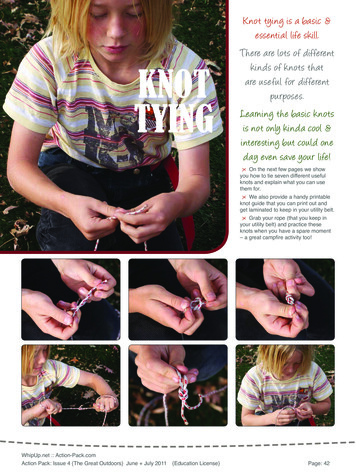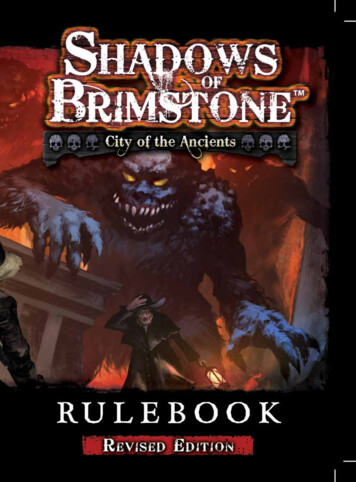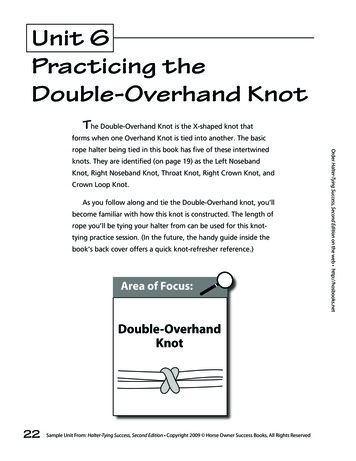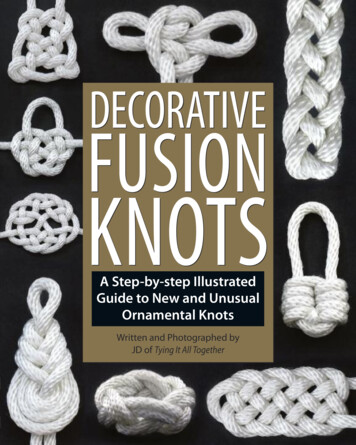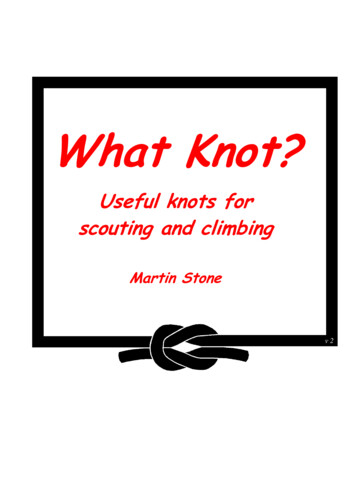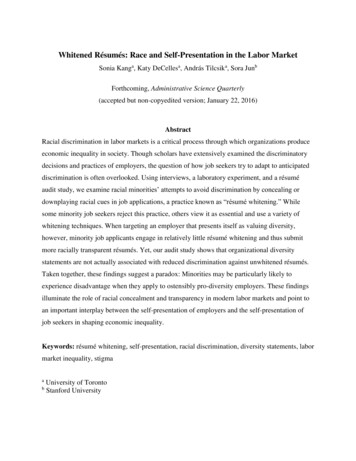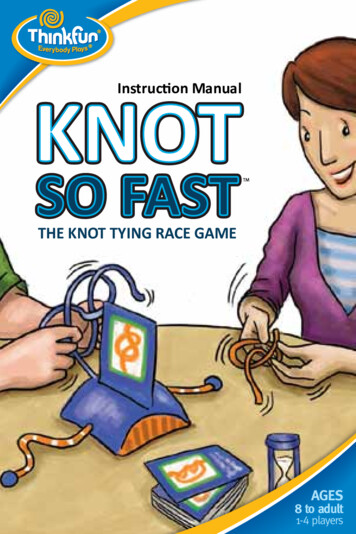
Transcription
KNOTInstruction ManualSO FASTTHE KNOT TYING RACE GAMEAges8 to adult11-4 players
Knot tying is fun! It is also greatmental exercise and helps improvehand-eye coordination.Team Play (2 or 4 players)Playing Knot So Fast makes knot tying REALLY fun!The knot challenges start easy to help you build confidence, the game rules make the game exciting toplay, and we provide variations on the rules so thatnovices can compete against experts.The first team to pull the Tug-o’-War Scorekeeper allthe way to its team’s side WINS!You will have a blast playing Knot So Fast!Knot So Fast includes: 2Tug-o’-War Scorekeeper4 Ropes: 2 blue and 2 orange4 Rings: 2 blue and 2 orangeDeck of 40 Challenge Cards30-Second TimerIf you have 3 players, refer to page 7 for “NON-TEAM Play” rules.Goal:Setup:1. Divide into two teams —the Blue Team and theOrange Team. Give each member of the BlueTeam a BLUE rope and an orange ring. Give eachmember of the Orange Team an ORANGE rope anda blue ring.2. Place the deck of challenges within easy reach ofall players. The first few times you play Knot SoFast, we recommend playing the challenges innumerical order (from Beginner to Expert). Onceyou’re familiar with the game, you may want toshuffle the deck and play the challenges in random order, or choose a small group of cards andplay only those until you master them.3
3. Place the Tug-o’-War Scorekeeper between the twoteams and set the Tug-o’-War rope to the middle.4 notches on each sideTo Play:1. Draw the top challenge from the deck, and placeit in the Tug-o’-War Scorekeeper. Make sure theblue knot illustration is facing the Blue Team.2. All players race to tie the knot pictured on thechallenge card. Teammates can verbally help oneanother to solve a challenge, but they may notmanipulate one another’s ropes.3. The first team to finish (the Calling Team) callsout “Finished!” and flips the 30-second timer. Tofinish, all players on a team must have completedtheir knots. Once the timer has been flipped,players on the Calling Team can no longer makeadjustments to their knots.44. The Opposing Team now has 30 seconds tofinish tying their knots.5. When the 30 seconds are up, both teams checkone another’s knots. A team calls out “Knot SoFast!” if they think the other team has tied one orboth of their knots incorrectly, and then inspectsthe knots for accuracy.Correctwrongwrong6. Score the round. (See page 6 for details.)7. Use the Scorekeeper by pulling the Tug-o’-Warrope gently towards you until you hear a click.Then, adjust the rope to the correct marking.One click per point!8. Draw the top card from the deck to begin thenext round.9. Play continues until one team pulls theTug-o’-War Scorekeeper all the way to itsside and wins the game!5
Team Play Scoring:The Calling Team Receives:2 points: if both of the Calling Team’s knots arecorrect and the Opposing Team cannotcomplete its knots in the extra 30 seconds.1 point: if both of the Calling Team’s knots arecorrect and the Opposing Team is ableto complete both of its knots in theextra 30 seconds.Goal:The first player to score 8 points is the WINNER!Setup:1. Place the deck of challenge cards within easyreach of all players.2. Place the Tug-o’-War Scorekeeper so that all playerscan easily see the challenge card displayed.0 points: if the Opposing Team finds that either ofthe Calling Team’s knots are tied incorrectly.3. Each player takes a rope and a ring (oppositecolored rope from ring). The players take a seat,where they can clearly see the challenge card.The Opposing Team Receives:4. You will need pencil and paper to keep score(not included).2 points: if either of the Calling Team’s knots areincorrect, regardless of whether theOpposing Team’s knots are correct.(This is a penalty against the CallingTeam for calling “Finished!” incorrectly.)0 points: if the Calling Team’s knots are both correct.6NON-TEAM Play (2, 3 or 4 players)To Play:1. Draw the top challenge from the deck andplace it in the Tug-o’-War Scorekeeper.(Note: If some players have more knot-tying experience thanothers, use the “Level the Playing Field” rules on page 10).2. Players race to tie the knot pictured onthe challenge card.7
3. The first player to finish tying the knot (the CallingPlayer) calls “Finished!”and flips the 30-secondtimer. The other players then have 30 seconds totry to complete their knots.4. When the 30 seconds are up, players should checkthe Calling Player’s knot to make sure it is correct.A player calls out “Knot So Fast!” if he/she thinksthe Calling Player has tied the knot incorrectly.5. Score the round. (See page 9 for details).6. A new card is drawn to begin the next round.7. The first player to get 8 points wins the game!Non-Team Play Scoring:The Calling Player Receives:2 points: if the Calling Player’s knot is correct andOpposing Players cannot complete theirknots in the extra 30 seconds.1 point: if the Calling Player’s knot is correct andat least one other player is able tocomplete the knot in the 30 seconds.0 points: if an Opposing Player finds that the CallingPlayer’s knot is tied incorrectly.The Opposing Players Receive:2 points: if the Calling Player’s knot is incorrect,regardless of whether the OpposingPlayers’ knots are correct. All OpposingPlayers will get these points. (This is apenalty against the Calling Player forcalling “Finished!” incorrectly.)0 points: if the Calling Player’s knot is correctly tied.89
Knot So Fast Play VariationsIf you are finding that one player wins all the timeor the game is lasting too long, you may want to trysome of the following game play variations.Short Game:When teams are evenly matched, Knot So Fast gamescan last a long time, with teams pulling the Tug-o’War rope back and forth in the middle. If you wantto specify exactly how long the game will last, makea rule to play with a set number of challenge cards.The team that leads when the last card is played isthe winner.Level the Playing Field:Some players are naturally better, or have moreexperience, at tying knots than others. To level theplaying field, have each team or player use their ownchallenge cards rather than having everyone competing to tie the same knot. Split into teams, make anassessment of relative strengths, then divide thechallenge cards into two sets—easier challenges forthe weaker team and harder for the stronger team.10Include only challenge cards that you want to play,you don’t need to use the entire deck.When you play, put both challenge cards into theTug-o’-War Scorekeeper back to back so that eachteam can see its selected challenge. All other rulesstay the same.Number of Challenges Selected:You may select as many or as few challenge cardsas you wish for a given game. Some players prefer toplay with only a few knots and to tie them again andagain, while others like to be surprised with a newchallenge each round. A great way to practice andmaster a knot is to choose only 4 or 5 challenges thatare rotated throughout a single game. Youwill be surprised at how much faster you’ll get attying each knot!Practice, Practice, Practice:Don’t wait for a friend to play Knot So Fast with you!Playing through the challenges on your own will giveyou a leg up when you’re playing competitively. Onceyou’re familiar with all of the knots, use the timer tosee if you can master them in 30 seconds or less!11
Number of Times to Play Each Challenge:If you’ve read this far, you probably already know theanswer to this! When you play Knot So Fast, you arepracticing how to tie a wide variety of knots drawnfrom all the major knot categories. So play Knot SoFast as much as you can; you should play eachchallenge LOTS of times!Notes about KnotsKnots may be the earliest tools invented by humans.We created knots using plant fibers to help makeclothes and to hunt using spears and arrows; earlysailors were masters at knot tying, (they needed to beto survive.) Virtually all knots were invented by peopleusing reasoning and craftsmanship to create a newtool that could be deployed to perform a specific task.When you play Knot So Fast, you are affirming a veryhuman drive. You are using your hands togetherwith your brain to create a tool. It’s really fun, andit’s really powerful!12Knots Categorized by Function:We have chosen the Knot So Fast challenges from fivemajor categories. To identify which category a knotbelongs to, look on the challenge card for the icon.Stopper KnotsStopper knots are usually used to stop a rope fromslipping through a hole. They are also used to preventthe strands at the end of a rope from fraying, toweight a rope or to provide a handhold. They areusually tied at the end of a rope, although some canbe tied in the middle.BindingsBinding knots are used to keep a rope from slippingor releasing its hold too easily, such as when tyingup parcels. Avoid using a binding knot to join twolengths of rope or to tie a rope to an object, since theknot is likely to come undone under strain.13
BendsA bend is used to join two lengths of rope together,lengthening the principal rope. For most bends, theropes need to be of equal thickness to tie a secureknot. A few bends are suitable for joining ropes ofdifferent thickness. A good bend can be easily untied,even after being put under considerable strain.Decorative KnotsKnots can be attractive and decorative in addition tobeing useful. Decorative knots often exhibit symmetric patterns which make them visually appealing.About the Inventor:HitchesDugald Keith was born in Melbourne, Australia, in1962. He majored in physics and worked in hightechnology before becoming a full-time board gameand puzzle inventor. His inventions have sold morethan 200 million at retail worldwide and won numerous awards. He continues to work on new ideas.LoopsKnot Consultant, Des Pawson, MBE:A hitch is used to tie a rope to an object, often a poleor a ring. Some hitches are designed to be tied quicklyand hold tight, particularly those used by sailors, whileothers can be untied with a brief tug on one end.Looped knots create a loop that may be tied to anotherobject or line. A loop may be dropped loosely over anobject to fix a rope in place, tied around a person’swaist or wrist, or threaded through a ring or an eyeof a hook. Loops can also be linked together to jointwo ropes that are substantially different in thick14ness. Some loops are fixed in place, while others aredesigned to slip and change size.A professional ropeworker for more than 35 years,Des Pawson is the author of a number of books onknots and ropework. He is co-founder and pastpresident of the International Guild of Knot Tyers.In 2007, he was awarded the MBE (Member of theBritish Empire) by Queen Elizabeth II for hiscontribution to the world of knots and rope.15
JOIN THE FAMILY!Visit www.ThinkFun.com and signup to be among the first to knowabout the hottest ThinkFun games,including special promotions andoffers. You can also follow us onandwww.ThinkFun.com16ThinkFun, Inc. 1321 Cameron St., Alexandria, VA 22314 USA. 2010 ThinkFun Inc.All Rights Reserved. Made in China #7090. INO1.
Knot tying is fun! It is also great mental exercise and helps improve hand-eye coordination. Playing Knot So Fast makes knot tying rEALLY fun! The knot challenges start easy to help you build con-fidence, the game rules make the game exciting to play, and we provide variations
